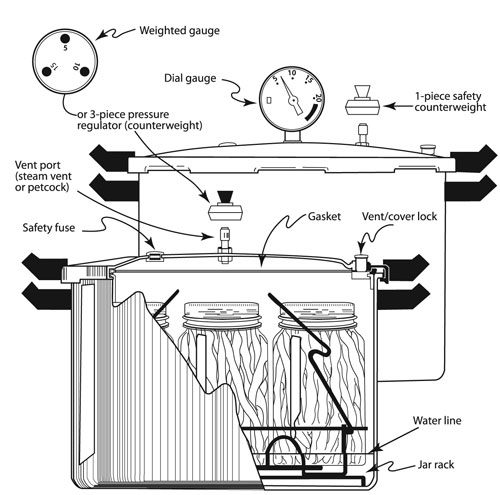Guide E-308
Nancy C. Flores and Cindy Schlenker Davies
College of Agricultural, Consumer and Environmental Sciences, New Mexico State University
Authors: Respectively, Extension Food Technology Specialist, Department of Extension Family and Consumer Sciences; and County Program Director/Extension Home Economist, Bernalillo County Extension Office, New Mexico State University. (Print friendly PDF)
Caution
This publication is intended for individuals with a basic understanding of canning procedures. For more detailed information, consult the USDA Complete Guide to Home Canning, which is available online at https://nchfp.uga.edu/publications/publications_usda.html or through your local county Extension office (https://aces.nmsu.edu/county/).
Because chiles are naturally low in acid, canning them requires special precautions that differ from those for canning high-acid foods. In particular, canning procedures must prevent the growth of microorganisms. Some bacteria cause food spoilage, while others produce toxins that cause illness or death. For example, Closstridium botulinum is a harmless bacterium in air. However, in the environment inside a canning jar with little or no acid (pH greater than 4.6), no oxygen, and temperatures between 40 and 120°F, this bacteria grows and produces a deadly toxin that can cause serious damage to the central nervous system or death when eaten in very small amounts (botulism).
Pressure processing is the only safe way to can chiles without adding any acid. Boiling water produces steam (Figure 1). Steam under pressure raises the temperature much higher than it normally would be without pressure. To prevent botulism, the internal temperature of canned chiles and other non-acid foods must reach 240°F. This guide provides the correct processing times and canner pressures for canning chiles safely in New Mexico.

Figure 1. Parts of a pressure canner (illustration adapted from USDA, 2009, for New Mexico State University by Susan B. Portillo).
To prevent the risk of botulism, low-acid foods not canned according to the USDA recommendations in this guide should be boiled even if no signs of spoilage are detected. Boil canned food for a full 10 minutes at elevations below 1,000 feet; add an additional minute of boiling time for each 1,000 of feet elevation (Table 1). Boiling destroys botulin toxin. If in doubt, always boil foods before tasting.
| Table 1. Boiling Times for Canned Foods to Destroy Botuln Toxin | |
| At Elevation (ft) | Boil Foods (minutes) |
| 2,000–2,999 | 12 |
| 3,000–3,999 | 13 |
| 4,000–4,999 | 14 |
| 5,000–5,999 | 15 |
| 6,000–6,999 | 16 |
| 7,000–7,999 | 17 |
| 8,000–8,999 | 18 |
| 9,000–9,999 | 19 |
Selecting and Preparing Chiles
Selecting Chiles
Choose chile that is mature, heavy for its size, smooth, symmetrical, bright green in color, fresh, and crisp. Avoid misshapen pods, shriveled skin, mold, soft spots, and bruises. Approximately 9 pounds of chiles will make 9 pints of canned chiles.
Blistering
The tough outer skin must be removed from chiles. Blistering the skin by one of the following methods makes removal easy.
Wash and dry chile. Use a knife to make a small slit in the side to allow steam to escape. Be sure the heat source is very hot. Turn chiles frequently to prevent scorching and ensure even blistering. Once the skins are evenly blistered, remove chiles from heat and spread out on a flat surface in a single layer to cool before peeling. For a crisper product, dip chiles into ice water as they are removed from heat. For more thoroughly cooked chile, place in a pan and cover with a damp towel for a few minutes.
Use one of the following heat sources for blistering chile. Chiles should be roasted for 6–8 minutes, turning occasionally, until the skin blisters and can be easily pulled away from the flesh.
Oven or broiler method. Heat your oven or broiler to 400–450°F (205–230°C). Place chiles on a pan in a single layer.
Stovetop method. Cover a stovetop burner with a layer of heavy wire mesh. Place chiles on the hot electric or gas burner.
Outdoor grill method. Place chiles on a charcoal grill about 5–6 inches above glowing coals, or in a gas grill heated to 400–450°F (205–230°C).
If chiles are not processed within two hours after blistering, place them in shallow containers in the refrigerator to prevent spoiling. This applies both to purchased, roasted chiles as well as to those roasted at home.
Salt
If desired, add 1/4 teaspoon of salt per half pint or 1/2 teaspoon salt per pint. Salt may be omitted since it is used only for flavor. For best results, do not use salt substitutes for canning since heat causes some substitutes to become bitter or develop a metallic taste. Instead, add salt substitutes just before serving.
General Canning Procedures
Use regular or wide-mouth Mason jars with self-sealing lids held in place by screw-on metal bands. The bands hold the lids in place during the processing and cooling periods, and can be removed and reused after cooling. Mason jars are made from tempered glass to resist high temperatures. Jars are available in 1/2 pint, pint, 1 1/2 pint, and quart sizes. Larger jars are not recommended for home canning. Do not reuse glass jars or bottles from commercially processed products such as mayonnaise because these jars will not withstand the pressure canner heating process.
Inspect jars carefully for cracks or chips and discard faulty ones. Wash jars in hot, soapy water and rinse thoroughly or clean using a dishwasher. To sterilize jars, keep jars hot in the dishwasher, a sink of hot water, or in a warm 180°F oven until they are filled. Check metal screw bands for signs of rust or dents. Discard corroded or dented bands. Use only new lids and follow the manufacturer’s directions for preparing lids for canning. Do not use lids that are missing any gasket compound, dented, deformed, or older than five years from date of manufacture.
Remove skins, stems, and seeds from chiles. Chiles can be cut in pieces or left whole. Pack chiles loosely and add boiling water to completely cover chiles. Leave a 1-inch headspace. Using a rubber or plastic spatula or knife that won’t nick or scratch the jar, slice between the chiles and the jar to ease out trapped air bubbles.
Use a clean, damp cloth or paper towel to wipe the rim and threads of each jar. Put on a new lid with a screw-on metal band to hold it in place; tighten comfortably. Process using a pressure canner.
“Follow These Steps for Successful Pressure Canning
-
Put 2 to 3 inches of hot water in the canner. [In areas with hard water, add 1 tablespoon of vinegar to reduce mineral deposits on jars.] Some specific products in this Guide require that you start with even more water in the canner. Always follow the directions with USDA processes for specific foods if they require more water added to the canner. Place filled jars on the rack, using a jar lifter. When using a jar lifter, make sure it is securely positioned below the neck of the jar (below the screw band of the lid). Keep the jar upright at all times. Tilting the jar could cause food to spill into the sealing area of the lid. Fasten canner lid securely.
-
Leave weight off vent port or open petcock. Heat at the highest setting until steam flows freely from the open petcock or vent port.
-
While maintaining the high heat setting, let the steam flow (exhaust) continuously for 10 minutes, and then place the weight on the vent port or close the petcock. The canner will pressurize during the next 3 to 5 minutes.
-
Start timing the process when the pressure reading on the dial gauge indicates that the recommended pressure has been reached, or when the weighted gauge begins to jiggle or rock as the canner manufacturer describes (Table 2).
-
Regulate heat under the canner to maintain a steady pressure at or slightly above the correct gauge pressure. Quick and large pressure variations during processing may cause unnecessary liquid losses from jars. Follow the canner manufacturer’s directions for how a weighted gauge should indicate it is maintaining the desired pressure. IMPORTANT: If at any time pressure goes below the recommended amount, bring the canner back to pressure and begin the timing of the process over, from the beginning (using the total original process time). This is important for the safety of the food.
-
When the timed process is completed, turn off the heat, remove the canner from heat if possible, and let the canner depressurize. Do not force-cool the canner. Forced cooling may result in unsafe food or food spoilage. Cooling the canner with cold running water or opening the vent port before the canner is fully depressurized will cause loss of liquid from jars and seal failures. Force-cooling may also warp the canner lid of older model canners, causing steam leaks. Depressurization of older models without dial gauges should be timed. Standard-size heavy-walled canners require about 30 minutes when loaded with pints and 45 minutes with quarts. Newer thin-walled canners cool more rapidly and are equipped with vent locks. These canners are depressurized when their vent lock piston drops to a normal position.
-
After the canner is depressurized, remove the weight from the vent port or open the petcock. Wait 10 minutes, unfasten the lid, and remove it carefully. Lift the lid away from you so that the steam does not burn your face.
-
Remove jars with a jar lifter, and place them on a towel, leaving at least 1-inch spaces between the jars during cooling. Let jars sit undisturbed to cool at room temperature for 12 to 24 hours.” (pp. I-21–22, USDA [2009])
Do not touch jars, lids, or rings until they are completely cooled.
-
Dial gauges on pressure canners should be checked annually to make sure they are accurate.
-
Weighted gauges on pressure canners are not accurate for elevations above 10,000 feet. Follow manufacturer instructions for proper use.
-
Rubber gasket must be pliable and in good condition to maintain seal of pressure canner.
|
Table 2. Processing Times for Chiles |
|||||
|
Pounds of pressure for elevation of |
|||||
|
Jar size |
Processing |
2,001– 4,000 ft |
4,001– 6,000 ft |
6,001– 8,000 ft |
8,001– 10,000 ft |
|
Half pint |
35 |
12 |
13 |
14 |
15 |
|
Pint |
35 |
12 |
13 |
14 |
15 |
|
Note: These instructions are for dial-gauge pressure canners. When using a pressure canner with a weighted gauge in New Mexico, use the 15-pound weight and the time periods given. |
|||||
“Testing Jar Seals
After cooling jars for 12 to 24 hours, remove the screw bands and test seals with one of the following options:
Option 1. Press the middle of the lid with a finger or thumb. If the lid springs up when you release your finger, the lid is unsealed.
Option 2. Tap the lid with the bottom of a teaspoon. If it makes a dull sound, the lid is not sealed. If food is in contact with the underside of the lid, it will also cause a dull sound. If the jar is sealed correctly, it will make a ringing, high-pitched sound.
Option 3. Hold the jar at eye level and look across the lid. The lid should be concave (curved down slightly in the center). If center of the lid is either flat or bulging, it may not be sealed.” (p. I-25, USDA [2009])
Reprocessing Unsealed Jars
Remove lids from unsealed jars and discard. Check the sealing surface of the jar for tiny nicks or cracks. If a jar has defects, discard it and replace it with another jar. If not, add a new lid and process for the same amount of time within 24 hours. Unsealed jars can be kept in the refrigerator and the food can be used within 3 to 4 days, or remove about an inch of the contents and freeze.
Storing Canned Food
Clean the outside of sealed, cooled jars with a damp towel dipped in a vinegar and water solution. Replace screw bands once they are completely dry, otherwise the bands will rust onto the lid and damage the lid and seal. Label with date and contents, including ingredients, and store in a cool (50–70°F), dark, dry place away from sun, light, or dampness. Tomato products are best if eaten within one year.
Accidental Freezing
Freezing may cause food in jars to spoil if the seal is broken. Freezing and thawing can cause food to soften and lose eating quality. Protect jars from freezing by wrapping them with layers of newspapers.
If Canned Food Spoils
Examine jars carefully before consuming. Check lids for a vacuum seal. NEVER taste food from an unsealed jar. Signs of food spoilage are streaks and dried food at the top of the jar, swollen lids, broken jar seals, rising air bubbles, and any unnatural color. Other indicators include bad or unnatural odor; spurting liquid; white, blue, green, or black mold; or foaming.
Dispose of any food you suspect of being spoiled. For safety, spoiled canned food and containers may need to be detoxified before disposal. Contact your county Extension office for detoxification instructions.
Elevation Adjustments
All communities in New Mexico are above sea level, varying from 3,000 to 10,000 feet in elevation, with differences even within a county.
Use Table 3 to determine the elevation of your community, and then select safe processing times for canning your vegetables. The boiling temperature of liquids is lower at higher elevations, and therefore food must be processed longer or at a higher pressure at high elevations.
|
Table 3. Elevations of Cities and Towns in New Mexico |
|||
|
City/Town |
Elevation (ft) |
City/Town |
Elevation (ft) |
|
Alamogordo |
4,350 |
Las Vegas |
6,450 |
|
Albuquerque |
5,000 |
Logan |
3,830 |
|
Artesia |
3,350 |
Lordsburg |
4,250 |
|
Aztec |
5,650 |
Los Alamos |
7,400 |
|
Bayard |
5,800 |
Los Ranchos de Albuquerque |
4,950 |
|
Belen |
4,800 |
Lovington |
3,900 |
|
Bernalillo |
5,050 |
Magdalena |
6,556 |
|
Bosque Farms |
4,864 |
Melrose |
4,599 |
|
Carlsbad |
3,100 |
Mora |
7,200 |
|
Carrizozo |
5,450 |
Mosquero |
5,550 |
|
Chama |
7,900 |
Mountainair |
6,500 |
|
Cimarron |
6,450 |
Portales |
4,010 |
|
Clayton |
5,050 |
Raton |
6,650 |
|
Cloudcroft |
8,650 |
Reserve |
5,749 |
|
Clovis |
4,300 |
Rio Rancho |
5,290 |
|
Columbus |
4,020 |
Roswell |
3,600 |
|
Corona |
6,664 |
Roy |
5,900 |
|
Corrales |
5,005 |
Ruidoso |
7,000 |
|
Cuba |
7,000 |
San Jon |
4,200 |
|
Deming |
4,300 |
Santa Fe |
7,000 |
|
Dexter |
3,500 |
Santa Rita |
6,300 |
|
Eagle Nest |
8,250 |
Santa Rosa |
4,600 |
|
Elida |
4,345 |
Silver City |
5,900 |
|
Española |
5,600 |
Socorro |
4,600 |
|
Estancia |
6,100 |
Springer |
5,800 |
|
Farmington |
5,400 |
Taos |
7,000 |
|
Fort Sumner |
4,050 |
Texico |
4,150 |
|
Gallup |
6,500 |
Tierra Amarilla |
7,460 |
|
Grants |
6,450 |
Truth or Consequences |
4,250 |
|
Hobbs |
3,650 |
Tucumcari |
4,100 |
|
Hurley |
5,700 |
Tularosa |
4,500 |
|
Jemez Springs |
6,200 |
Vaughn |
5,950 |
|
Las Cruces |
3,900 |
Wagon Mound |
6,200 |
For more on this topic, see the following publications:
E-311: Freezing Green Chile / Como congelar chile verde
https://pubs.nmsu.edu/_e/E311/
E-324: Processing Fresh Chile Peppers
https://pubs.nmsu.edu/_e/E324/
E-326: Home Canned Sweet Spreads Made with Green Chile
https://pubs.nmsu.edu/_e/E326/
|
Original author: Mae Martha Johnson, Extension Nutrition Specialist. Subsequently revised by Alice Jane Hendley, Food and Nutrition Specialist; and Martha Archuleta, Extension Food and Nutrition Specialist. |

Nancy Flores is the Extension Food Technology Specialist in the Department of Extension Family and Consumer Sciences at NMSU. She earned her B.S. at NMSU, M.S. at the University of Missouri, and Ph.D. at Kansas State. Her Extension activities focus on food safety, food processing, and food technology.

Cindy Schlenker Davies is the County Program Director and Extension Home Economist at NMSU’s Bernalillo County Extension Office. She earned her B.S. at Eastern New Mexico University and her M.A. at NMSU. Her Extension and public outreach work focuses on food processing and preservation and food safety.
To find more resources for your business, home, or family, visit the College of Agricultural, Consumer and Environmental Sciences on the World Wide Web at pubs.nmsu.edu
Contents of publications may be freely reproduced for educational purposes. All other rights reserved. For permission to use publications for other purposes, contact pubs@nmsu.edu or the authors listed on the publication.
New Mexico State University is an equal opportunity/affirmative action employer and educator. NMSU and the U.S. Department of Agriculture cooperating.
Revised November 2015


